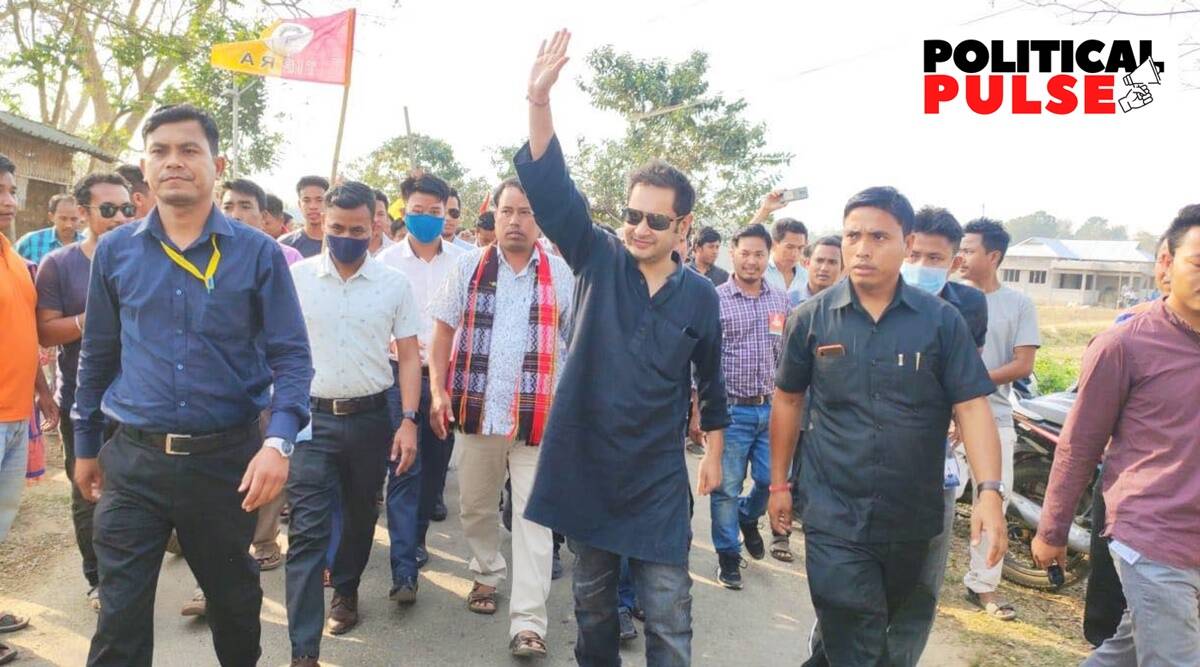Tripura tribal politics heats up over separate state demand
Fuelled by the demand for a separate state for Tripura’s indigenous communities, tribal politics is heating up in the BJP-ruled north-eastern state.
Try Adsterra Earnings, it’s 100% Authentic to make money more and more.

Among the tribal parties who have joined hands for separate statehood are fierce political rivals, the TIPRA Motha (Tipraha Indigenous Progressive Regional Alliance) and the IPFT (Indigenous People’s Front of Tripura), the BJP’s ally. Pressing for a separate state for Tripura tribals for the sake of their “survival and interests”, they even held a sit-in demonstration at Jantar Mantar in the national capital recently.
Ranging from anti-monarchical agitation to armed struggle for self-determination, to democratic agitation for separate statehood now – Tripura’s tribal politics has come a long way in the last seven decades since Independence.

 Pradyot Debbarman with leaders and workers of tribal parties at Jantar Mantar. (Photo: Twitter/@PradyotManikya)
Pradyot Debbarman with leaders and workers of tribal parties at Jantar Mantar. (Photo: Twitter/@PradyotManikya) The IPFT, which has two ministers in the Biplab Deb-led Tripura government, had raked up the cause of “Tipraland”, a proposed separate state for tribals of Tripura, in 2009. The demand catapulted the party to win 8 seats in the 2018 Assembly election, that it contested as a pre-poll coalition partner of the BJP.
In February this year, Pradyot Kishore Manikya Debbarman, 43-year-old scion of Tripura’s erstwhile royal family – who had resigned as the state Congress president in 2019 – floated the TIPRA Motha. Calling for “thansa” or unity among tribal outfits, he gave the slogan of “Puila jaati, Ulobo jaati” (community first, community last), that led to several tribal outfits merging with his party. The Manikya royal family has always played a significant role in the Tripura politics.
In the Tripura Tribal Areas Autonomous District Council (TTAADC) elections in April this year, the TIPRA Motha contested on the plank of its demand for “Greater Tipraland” and swept the polls.
The TIPRA Motha bagged 18 of the 28 seats in the TTAADC polls, securing 37.43 per cent votes. Its ally Indigenous Nationalist Party of Twipra (INPT) got 9.30 per cent votes,
The TTAADC covers nearly 70 per cent of Tripura’s total area. It has got a set of protective Constitutional safeguards for its 19 officially notified tribal communities, including statutory protection of tribal land. One third of the state’s population lives in its belt.
Debbarman’s “Greater Tipraland” is essentially an extension of the IPFT’s demand of Tipraland, a separate state for Tripura tribals to be carved out with the TTAADC territory. His demand seeks a separate state for Tiprasa – involving tribals and legal non-tribal residents of Tripura (illegal immigration from Bangladesh is a major issue in the state). The proposed Greater Tipraland also seeks to include tribals spread across different states of India like Assam, Mizoram etc, and even “help” Tripuri tribals living in parts of Bangladesh through socio-cultural development.
The tribal outfits’ demand for a separate state seems to stem mainly from the perceived sense of the indigenous communities’ anxiety over the change in Tripura’s demographics, which has reduced them to a minority. It has been attributed to the displacement of Bengalis from the erstwhile East Pakistan between 1947 and 1971. From 63.77 per cent in 1881, the tribal population in Tripura came down to 31.80 per cent by 2011. In the intervening decades, ethnic conflict and insurgency gripped the state, which shares a nearly 860-km long boundary with Bangladesh.
The emergence of the TIPRA Motha in Tripura politics could be attributed to two reasons – the popularity of a royal family member and the political vacuum in the state’s tribal space in the wake of the CPM-led Left’s debacle in 2018 Assembly elections and the IPFT’s rout in the TTAADC polls.
While the TIPRA Motha’s call for Greater Tipraland has resonated among a large section of tribals, the faultlines among various tribal outfits have also surfaced.
On 16 December, Debbarman was heckled by the activists of the Tripura Peoples Front (TPF) as clashes broke out between them and the TIPRA Motha supporters after the TPF took out a rally without permission at Khumulwng, headquarters of the TIPRA-headed TTAADC.
The TPF is a small tribal outfit, which seeks the identification and deportation of illegal Bangladeshi immigrants besides the NRC revision in the state. It now faces a boycott call given by the Twipra Student Federation (TSF), a tribal students body, over Debbarman’s heckling.
As the competition between various tribal parties intensifies over the demand for a separate state, the issue is set to shape Tripura’s politics in coming months, with the next Assembly polls slated for 2023.
Although Debbarman denies his statehood demand is centred along ethnic lines, claiming that it arose due to a sense of alienation among tribals after decades of under-development, the issue is now forcing national parties – which are not in favour of splitting Tripura for carving out a separate state – to rework their strategies.
In the TTAADC polls, which it also contested in alliance with the IPFT, the BJP had fought from 11 seats and bagged 9, garnering 18.72 per cent votes as against its 7.87 per cent vote share in 2015. Its tribal ally IPFT, however, fared disastrously in these polls, drawing a blank.
The BJP had put the onus of not winning the ADC on the IPFT. In a bid to work out a counter-narrative against the statehood demand, the ruling party has also got approval for the Tripura ADC to to be developed into a Territorial Council.
The CPM-led Left Front, which was ousted from power in the 2018 Assembly polls after their consecutive 25-year rule, still sees a steady erosion of their support base among various communities including tribals.
The Congress party continues to remain in the political wilderness in the state.
Commenting on its dismal performance in the ADC polls, an IPFT spokesperson said, “Ups and downs are common in politics. But our ideology is the best. TIPRA Motha has just modified our issue and started their movement. It is clear that the Constitution doesn’t have direct provisions for framing this kind of state outside the territory of India. Our Tipraland demand is a realistic and constitutionally possible demand. Our support base will revive again.”
Of Tripura’s total 60 Assembly seats, 20 are Scheduled Tribe-reserved seats.
The BJP is expected to keep its alliance options open for the 2023 polls. It has maintained that its key issue will remain development.
The Left says it would contest the 2023 elections for “restoring democracy and rule of law”. Tripura CPM secretary Jitendra Chaudhury, while blaming both the BJP and the IPFT for political violence in the state, claims his party would emerge victorious in all tribal seats in 2023 polls.
After his party swept the TTAADC polls, Debbarman has emerged as a major player in Tripura politics. It is to be seen how he negotiates the state’s tricky political landscape in the run-up to the next Assembly polls, especially over his Greater Tipraland demand.
More Story on Source:
*here*
Tripura tribal politics heats up over separate state demand
Published By







